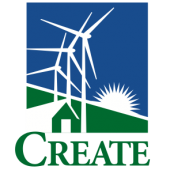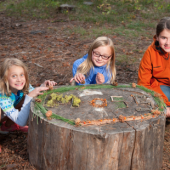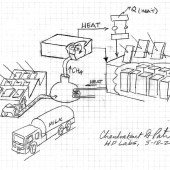
In order to develop bioenergy into a viable industry capable of providing valuable energy and employment, there is an immediate need for a workforce prepared for the impending challenges of this emerging, interdisciplinary industry. To meet this need, it is necessary to identify and prioritize the topics that should be included in a college-level bioenergy curriculum. We implemented a three-round Delphi study to determine components of a college bioenergy curriculum in the US, by establishing consensus among a panel of American bioenergy experts. Round One consisted of a single open-ended question: Keeping in mind the future of a commercial bioenergy industry, what content knowledge should a student have upon completion of a college-level bioenergy curriculum? Responses were qualitatively coded into themes, and experts were asked to rate the importance of each theme using a five-point Likert-type scale during subsequent rounds. The final round resulted in 13 themes: Energy Basics, Types of Bioenergy, Environmental Impacts (including Life Cycle Analysis), Current Technologies, Societal Issues, Logistics, Policy, Biomass Composition, Non-Bioenergy-Specific Fundamentals, Biomass Production, Conversions, Bioenergy Market, and Business-Related Knowledge. Results will be used to bolster the existing bioenergy education initiative at Oregon State University, and can provide guidance to other institutions in the US and abroad interested in developing similar bioenergy education programs.
Continue Reading
Abstract: When examining energy consumption in human history, it is evident that society is entering a new era where the costs of energy generation from renewable sources are now competitive with fossil fuel generation. In light of this advance, this report examines recent milestones in the renewable energy sector, and projects what the near future might hold. In the years ahead, growth in the renewable industry will create increased demand for a trained workforce of scientists, engineers, and technicians with knowledge of renewable energy. Faculty development and educational programs will play a key role in preparing the next generation of renewable energy professionals. This report highlights the impact of one such initiative that was funded by the National Science Foundation. Educators are called to join the effort to create a sustainable future powered by renewable energy.
Continue Reading
As scientific research evolves information in (K-12) curriculum can quickly become outdated. New research can greatly change the way we teach about science topics and the content we want students to understand. Educators, both formal and informal, can enrich their science curriculum by pulling from current research. Navigating the complexities and unanswered questions alongside scientists can provide a platform for discussion and insight into the nature of science and research that many students are not aware of, providing both a unique experience and valuable lesson on problem solving. Using lessons recently created in tandem with current aviation biofuels project, this article demonstrates the steps educators can take to use ongoing research to create lessons for their own audiences. As often noted in media and current events, finding a reliable, abundant, and sustainable source of transportation fuel is a high priority. One current research effort is being led by the U.S. Department of Agriculture–funded Northwest Advanced Renewables Alliance (NARA), which combines research efforts from industry and educational institutions to build a renewable supply chain for aviation biofuel. This article highlights steps suggested for educators to break down current research to create lessons for their audiences through an explanation of lessons that were developed using NARA research as a foundation. These steps include: Define the theme, Provide the background, Break down the parts, and Draw the parallels.
Continue ReadingRenewable energy has become an important priority to the development of human society. The authors proposed an innovative “Proposing-Learning” model to improve the renewable energy education at the university level, in which the student community was extensively involved in the selection, development and assessment of a capstone project. In this project, a hybrid energy harvesting system prototype comprised of a bamboo wind turbine and solar panels was developed at the University of Vermont. The project idea was initially proposed through an online collective intelligence voting system, and then discussed in a committee comprised of students, faculty, staff and alumni members. A group of undergraduate students, representing different engineering disciplines, worked with the faculty advisors to create the prototype successfully. Good assessment was received from the students and local community for the project. Finally, the authors discussed the future effort to improve this education model and the potential applications of the hybrid renewable energy system.
Continue Reading
Teaching sustainability invariably involves teaching about energy – its use, its sources, its
environmental impacts, and its social implications. This paper explores how one renewable
energy alternative – biogas – is adapted and applied across scale and culture. Biogas is made by
capturing the methane released during anaerobic digestion of organic matter such as manure,
sewage, and food waste. In Nepal, biogas is a household scale technology used to create a
cooking fuel that replaces firewood and improves both environmental and human health. In the
United States, biogas is used as part of large-scale waste management systems for livestock,
wastewater treatment, and landfills to create electricity for on-site use and for sale into electric
grids. In Sweden, biogas is used as part of a regional effort to reduce greenhouse gas emissions
and fossil fuel usage by using locally generated biogas for district heating, electricity, and
vehicular fuel. By comparing these three cases, we gain insight into how one technology is
adapted across diverse needs and from household to regional scales in the pursuit of more
sustainable energy practices. Such an exercise can be an asset in the classroom to teach students
about the importance and relevance of place-based solutions that address diverse cultural and
economic realities.